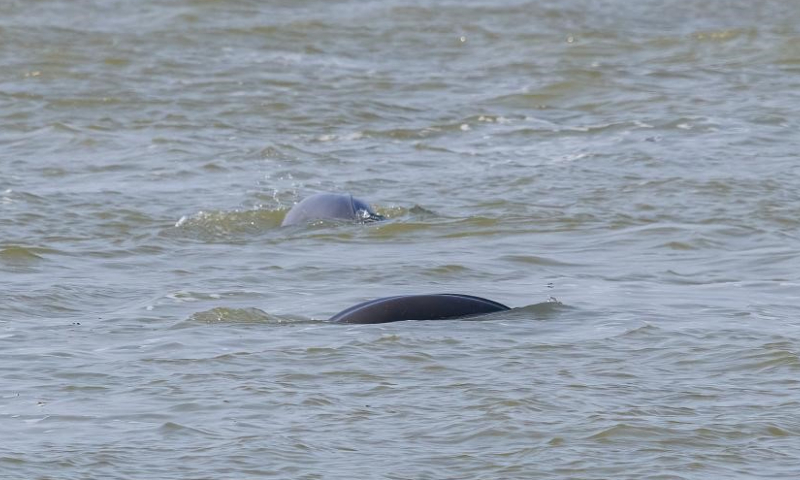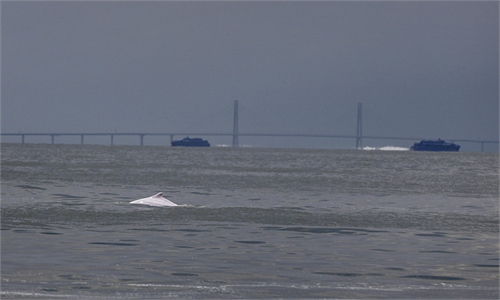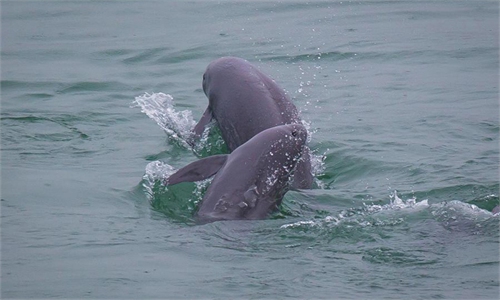Number of 'smiling angel' dolphins in Yangtze River rebounds after fishing ban: scientific survey

Yangtze finless porpoises are seen in the Yangtze River in Nanjing of East China's Jiangsu Province on February 19, 2023. Photo: IC
The number of endangered "smiling angel" dolphins in the Yangtze River saw a rebound to 1,249 last year, up one-fifth from five years ago, after the implementation of a fishing ban in the Yangtze River, according to the latest scientific survey.
The Ministry of Agriculture and Rural Affairs (MARA) announced on Tuesday that 1,249 Yangtze finless porpoises, a critically endangered freshwater dolphin species endemic to China's longest river, were observed during a scientific survey conducted from September to October in 2022.
According to the survey, there were 595 dolphins observed in the main stream of the Yangtze River, 492 in the Poyang Lake in East China's Jiangxi Province, and 162 in the Dongting Lake in Central China's Hunan Province.
The scientific survey in 2022 was the first basin-based systematic survey of Yangtze finless porpoises after the implementation of the Yangtze River fishing ban in January 2020 and the passing of Yangtze River Protection Law in December 2020, following three previous surveys in 2006, 2012 and 2017 when the number of Yangtze finless porpoises observed fell from 1,800 to 1,045 then to 1,012, according to an official from MARA.
The official said Yangtze finless porpoises' activity areas were also found much larger than before, with many first seen in some river sections.
The Yangtze finless porpoise is called the "smiling angel" in China because of its mouth fixed in a permanent grin. After its better-known cousin, the baiji dolphin, was declared "functionally extinct" in the same waters in 2007, experts believe the finless porpoise is the Yangtze's last surviving mammal.
The historic rebound of these "smiling angels" should be first attributed to the fishing ban in the Yangtze River basin which guarantee the dolphins' source of food, said Jiang Meng, the secretary-general of the Nanjing Yangtze Finless Porpoise Conservation Association, who participated in the 2022 survey in Jiangsu.
Jiang told the Global Times on Tuesday that the removal of many plants along the Yangtze River and the improvement of docks have provided clean water for the dolphins' habitat. "We believe the number of Yangtze finless porpoise will continue to increase in 2023."
Despite that the natural decline of Yangtze finless porpoise has been effectively curbed, experts warn that protective measures cannot be loosened as the dolphins still faced some fundamental problems, such as the block of some water conservancy projects on their communication, the habitat occupation by human activities, and the impact of shipping.
Jiang suggested removing water gates in some suitable river channels to restore the original ecological environment for fishes and to circle areas in the dolphins' activity areas where ships cannot pass or sail at a limited speed.
The protection of Yangtze finless porpoises is just a miniature of China's effort in protecting the ecological system when sometimes human activities contradicted the living and reproducing with other creature. "You need to make a choice. Earn more money right now, or preserve the living environment for future generations," said Jiang.
China has made its choice, as the MARA vows to fully continue the 10-year ban on fishing, further increase the protection of rare and endangered species, and restore important habitat.



